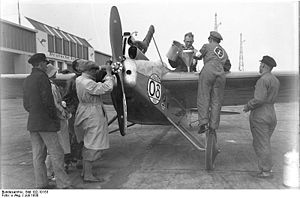- PWS-50
-
PWS-50 PWS-50 of Z. Babiński during the Challenge 1930 Role Sports plane Manufacturer PWS First flight 1930 Retired 1933 Status prototype Number built 1 The PWS-50 was a Polish sports plane of 1930, a single-engine mid-wing monoplane, constructed by the Podlaska Wytwórnia Samolotów (PWS), that remained a prototype.
Contents
Design and development
The plane was designed in 1929 in Podlaska Wytwórnia Samolotów, on factory's initiative, specially to participate in the Challenge International de Tourisme 1930 international touring aircraft contest. A preliminary design was made by Major Wacław Makowski, a construction sketches by Augustyn Bobek-Zdaniewski. The plane was built and first flown in spring of 1930 by Franciszek Rutkowski in Biała Podlaska.
Operational history
The prototype, with markings SP-ADB, took part in the Challenge 1930 international contest in July 1930, flown by Zbigniew Babiński. He was disqualified for time infringement, but completed the rally off the contest.[1]
Later the plane was used for a short time by an Aviation Club of the PWS factory. It took part in some competitions in Poland, without much success, only in June 1933 J. Szałowski won the 3rd place in PWS-50 in the 1st Flight of North-Western Poland. During a contest in autumn 1930 the plane was damaged and later repaired. In 1932 the plane received a name "Podlasianka" (a female of Podlasie region). In late June 1933 the plane was damaged in a crash in Warsaw, and then was broken up.
Description
It was a single-engine cantilever mid-wing monoplane, of a wooden construction. A fuselage was rectangular in cross-section, covered with plywood. Trapezoid single-section wings with rounded tips, two-spar, plywood and canvas covered. Crew of two, sitting side-by-side between spars, in an open cockpit, fitted with a windshield and dual controls. A luggage compartment was behind the cockpit. The plane had a fixed conventional landing gear, with a rear skid. The Flight described the PWS-50 as: the view appeared very good and the construction sound.[2]
The engine was 4-cylinder air-cooled straight Cirrus III in front, 85 hp nominal power and 94 hp take-off power. Two-blade wooden propeller of a fixed pitch. A fuel tank behind a cockpit had a capacity 100 l and could be dropped in emergency. Fuel consumption was 26 l/hour.
Specifications
General characteristics
- Crew: 1, pilot
- Capacity: 1, co-pilot or passenger
- Length: 7.1 m (23 ft 3 in)
- Wingspan: 11 m (36 ft 1 in)
- Height: 2.1 m (6 ft 10½ in)
- Wing area: 20 m² (215 ft²)
- Empty weight: 429 kg (944 lb)
- Loaded weight: 650 kg (1,430 lb)
- Useful load: 221 kg (486 lb)
- Max takeoff weight: 735 kg (1,617 lb)
- Powerplant: 1 × Cirrus III 4-cylinder air-cooled straight engine, 94 hp (70 kW)
Performance
- Maximum speed: 155 km/h (96 mph, 84 knots)
- Cruise speed: 126 km/h (78 mph, 68 knots)
- Stall speed: 65 km/h (40 mph, 35 knots)
- Range: 500 km (311 mi, 270 NM)
- Service ceiling: 3400 m (11,150 ft)
- Rate of climb: 2.8 m/s (551 ft/min)
- Wing loading: 32.5 kg/m² (6.65 lb/ft²)
See also
References
- ^ Krzyżan, Marian. Międzynarodowe turnieje lotnicze 1929-1934 [International aviation competitions 1929-1934], Warsaw 1988, ISBN 83-206-0637-3, p.45. According to Glass, op.cit., the pilot had to quit from a rally due to illness, but it is less likely.
- ^ Flight, July 25, 1930, p.854.
- (Polish) Andrzej Glass: "Polskie konstrukcje lotnicze 1893-1939" (Polish aviation constructions 1893-1939), WKiŁ, Warsaw 1977, p.186-187
External links
Aircraft produced by Podlaska Wytwórnia Samolotów Aircraft License built Avia BH-33 as PWS-AGliders PWS-101 • PWS-102 • PWS-103Lists relating to aviation General Aircraft (manufacturers) · Aircraft engines (manufacturers) · Airlines (defunct) · Airports · Civil authorities · Museums · Registration prefixes · Rotorcraft (manufacturers) · TimelineMilitary Accidents/incidents Records Categories:- Polish sport aircraft 1930–1939
- PWS aircraft
Wikimedia Foundation. 2010.

